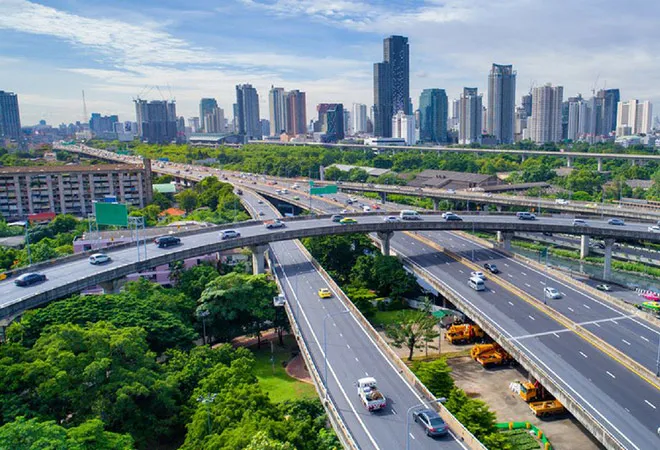-
CENTRES
Progammes & Centres
Location
Given that migration into cities is expected to increase significantly shortly, the prospect of building new habitats must be looked at more closely.

In an address to the participants of the ‘Sankalp Se Siddhi–New India, New Resolve Conference’ in Mumbai on 8 July 2022, the Union Minister for Road, Transport and Highways advised the Maharashtra government to create townships along new highways being built between major cities such as Pune-Aurangabad national highway, Delhi-Mumbai expressway, Nagpur-Mumbai Samruddhi Mahamarg, and the Pune-Bengaluru expressway. These national road connectivities are currently under implementation. He added that his ministry would seek the Cabinet’s approval for allowing the construction of smart cities, townships, logistic parks, and industrial clusters along the national highways. In line with the Minister’s reference to roadside townships, this article will explore in detail about the desirability of such towns.
It is expected that by 2050, India, standing today at an urban percentage of about 35.86 percent, will have more than half the country’s population living in cities. This would not be merely on account of internal population multiplication or geographical expansion of the cities by subsuming neighbouring villages. It also presupposes a massive rural migration to the cities, all adding up to about 300 million people. This would be in more than approximately 500 million already living in urban India.
Given the challenges that megacities are countenancing today and the fresh difficulties that climate change is likely to bring, it appears logical to plan for an urban dispersal strategy.
In the above context, it makes sense to look at the pattern of urbanisation India would like to promote. Would we continue to rely on the cities that are bearing the brunt of migration or look for decentralising migration to several other urban locations? Given the challenges that megacities are countenancing today and the fresh difficulties that climate change is likely to bring, it appears logical to plan for an urban dispersal strategy. In looking for other places to spread out urbanisation, there is the alternative of either selecting existing small towns that have the competitive advantage to blossom into large urban habitats or go for erecting completely green-field cities. building townships along highways and expressways are thus of national importance as it will allow a range of advantages including connectivity.
Looking at the state of India’s megacities that have ballooned due to migration, it would be unwise to further burden them with even larger populations. The quality of life in these cities is already deteriorating and additional load will only make the situation worse. The alternative of selecting small towns with the potential to grow seems to be a good idea. And given the massive inflow of migration that is expected, it would be wise to make a careful selection and build them up as viable urban destinations. However, that does not mean that cities cannot be built from scratch in light of the enormous volume of India’s urbanisation.
Building new habitats is not an entirely novel initiative. In recent times, Brasilia and Canberra were completely green-field creations. Egypt is building a new capital, some 45 km east of Cairo. Saudi Arabia is engaged in the construction of a brand-new zero-carbon city named “The Line”. It is planned as a linear city of one million people, running 170 km long, with a width that would be walkable in a mere five minutes. Oman is erecting “Duqm” in the middle of the desert which is designed to be twice the size of Singapore. Indonesia, Malaysia, China, Senegal, Japan, Maldives, the United States, and many other nations are attempting new cities. Most of these are being crafted on the modern principles of sustainability. They will be smart and eco-friendly, will operate entirely on renewable energy, discard fossil fuels, and discourage or discard personalised vehicles. Many of these cities are looking to incorporate the latest technologies into their built environment. These comprise robotics, blockchain, cryptocurrency, hydrogen fuel cells for energy, automated driving, artificial intelligence, and covering rooftops with photovoltaic panels to generate solar power.
One of the arguments against new cities is the length of time that they take to be built and a large amount of money they require to get fully equipped.
Several major factors work in favour of building new cities. Firstly, since the land is predominantly unbuilt and uninhabited, it can be planned properly with no retrofitting required. Secondly, there is a wide choice of in-site selections. One can put them up where supporting infrastructures such as land, water, communication, and markets are available nearby and at a low price. These would help keep down costs and make the city affordable, and economically competitive. Furthermore, the volume of migration mentioned above rules out an ‘either-or’ situation. We need more urban locations, not fewer New sites, therefore, would allow the erection of modern cities built on modern concepts.
One of the arguments against new cities is the length of time that they take to be built and a large amount of money they require to get fully equipped. It is obvious that just as migration would be over a period, new cities need not come up all at once, but may be phased out over a period. Secondly, the land would get acquired at prices much lower than the value that they would ultimately attract in a built urban locale. Revenue from the sale of land should, therefore, fund a large part of the infrastructure. In China’s new city building boom that was at its height around 2011, transactions in the land brought in approximately three-fourths of the revenue stream for the country’s municipal governments and plots for urban construction were off-loaded in the market at a 40-fold profit.
Apart from the infrastructural advantages pointed out above that one has to look for, the technologies on which they would be based, the kind of employment that they would generate, and the kind of economy that they would favour will need to be decided.
In the cited background, the minister’s advice to look for creating cities along highways was sound. However, the caveat is that the concepts of individual cities have to be thought through. Apart from the infrastructural advantages pointed out above that one has to look for, the technologies on which they would be based, the kind of employment that they would generate, and the kind of economy that they would favour will need to be decided. These matters are complex and would have to be defined through wide consultations among government agencies, financial institutions, investors, and businesses that would like to set shop in these cities.
Cities in India, however, cannot be custom-built merely for the affluent who are looking for second homes. The majority of migrants into cities are going to be from poor households. Therefore, while cities must attract high-value professionals and allow for luxury, recreation, and quality properties, they would also have to be equitable and provide quality of life for all their residents. The provision of affordable housing, informal employment, and reasonably priced health and educational services cannot be brushed under the carpet.
The views expressed above belong to the author(s). ORF research and analyses now available on Telegram! Click here to access our curated content — blogs, longforms and interviews.

Dr. Ramanath Jha is Distinguished Fellow at Observer Research Foundation, Mumbai. He works on urbanisation — urban sustainability, urban governance and urban planning. Dr. Jha belongs ...
Read More +